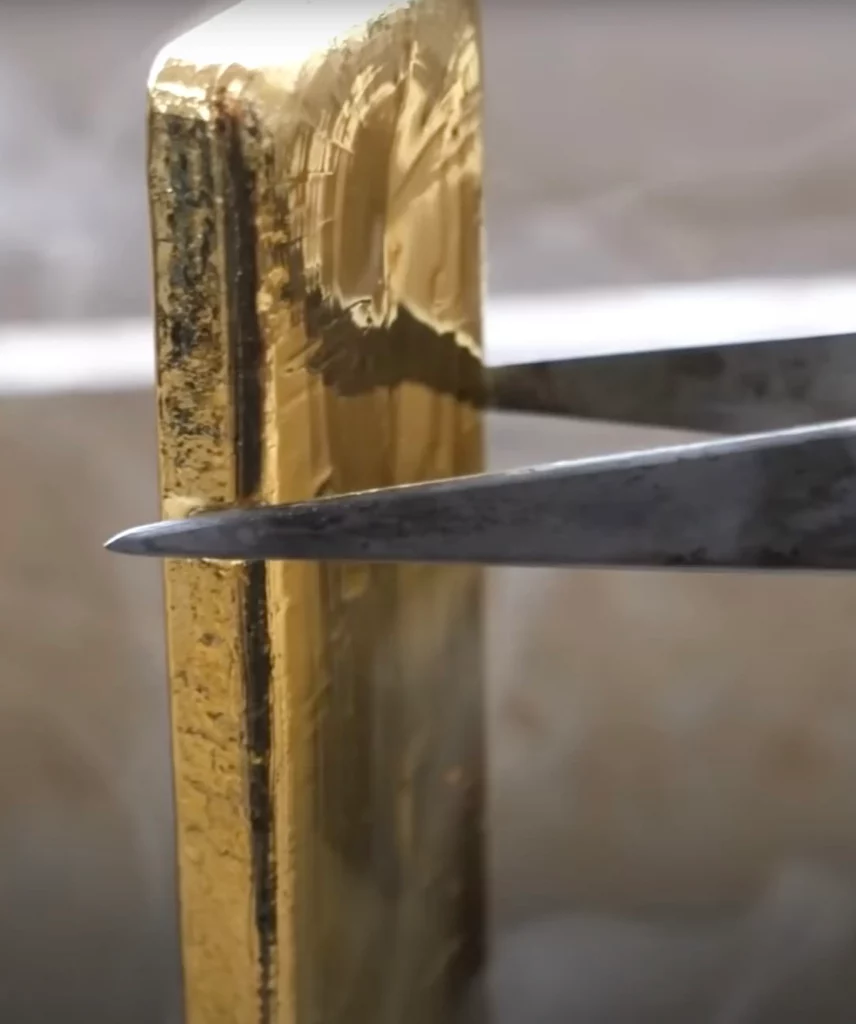Gold melting and gold smelting are two different terms. Melting gold involves heating it until it becomes a liquid, allowing for shaping into bars, coins, or other forms. Gold smelting, however, is a complex method used to purify gold from impurities through heat or chemical-reducing agents.
During smelting, the ore breaks down, with unwanted elements turning into gas or slag, leaving only the gold. The reducing agent reacts with the impurities in the ore, breaking them down and separating them from the gold. As a result, the impurities are converted into gases or slag, while the gold remains in its metallic form.
How does Gold Smelting work?
Gold smelting involves heating gold ore or scrap in a furnace to high temperatures, causing the metal to melt. As it melts, impurities rise to the surface and we can skim them off. We then pour the molten gold into molds or cast it into desired shapes, and it solidifies as it cools.
Gold Smelting Process
Purified gold is melted and poured into bars or smaller quantities called bullion. This process requires significant energy, often from coal, resulting in environmental effects like increased greenhouse gas emissions. Modern methods, such as induction furnaces, are employed for gold smelting. The basic steps used in the smelting of gold are as follows:
| Pulverizing | Crushing the ore into small pieces. |
| Heating | Placing the material in a furnace and heating it to temperatures exceeding the gold’s melting point. |
| Flux Addition | Adding chemicals known as flux to aid in separating any remaining impurities. |
| Cooling | Allowing the mixture to cool down, making it possible to chip away impurities. |
| Purity | Resulting gold nuggets are typically around 90% pure. |
| Refining | Further refining the 90% pure gold nuggets to achieve higher levels of purity. |
Pulverizing or Ore Processing
This is the first step in gold smelting, involving ore crushing. Breaking down the ore into smaller fragments increases its surface area, making subsequent extraction and refining processes more efficient. Pulverizing sets the foundation for the entire smelting process, transforming raw material into valuable gold.

Induction Furnace Treatment
After pulverizing the gold ore, the next step is melting it. We place the material in a furnace where the temperature exceeds the melting point of gold (1,064 degrees Celsius or 1,947 degrees Fahrenheit). We use blast furnaces, which forcefully introduce air into their flames, to achieve such high temperatures. This intense heat liquefies the gold, separating it from impurities for further purification and shaping processes.

Chemical Addition
Chemicals such as sodium nitrate, silica, lead oxide, sulfuric acid, and nitric acid are added to facilitate the bonding of impurities. This causes impurities to oxidize and rise to the surface, allowing for their removal. Trained professionals with the right equipment handle this process, ensuring safety and effective purification.
Gold Purity
After smelting, we obtain gold nuggets, known as gold dore bars, containing both gold and silver. These bars, typically in 10-pound or 20-pound sizes, are convenient for storage and transportation. Further refinement separates gold from silver. Gold purity after smelting is generally 90%, refined further through methods like the Miller process and the Wohlwill method.

Miller Process:
We use chlorine to react with the molten mixture, separating additional impurities. The purity of gold reaches approximately 99.5% through this process, commonly employed for refining gold.
Wohlwill Method:
An electrolytic process is known for achieving exceptional purity levels of 99.999% in precious metals.
My apologies for that oversight. Let’s switch it to active voice: Gold nuggets undergo immersion in an electrolyte solution, and an electric current eliminates impurities, refining gold to an extraordinarily high degree of purity.
Bullion bars
We further refine the resulting gold and shape it into practical forms, typically bullion bars. Achieving 100% pure gold remains unattainable despite advancements in smelting techniques. The highest purity achieved is 99.9999% or 999.999 fineness gold, reached by the Australian Perth Mint in 1957.
Gold recycling, accounting for approximately 25% of the total each year, plays a significant role in the market. The majority of recycled gold (90%) comes from jewelry and scrap gold, contributing to the continual cycle of gold reuse and sustainability.
Application of Gold Smelting
Gold smelting is crucial for obtaining pure gold suitable for various applications. It facilitates the extraction of gold from its raw form, ensuring cleanliness and high quality through a safe and effective process. Post-smelting, the gold finds utility across industries and businesses for diverse purposes.
Safety and Environmental Concerns
In lieu of mercury, which poses risks, small-scale gold miners can opt for direct smelting to extract gold from their concentrates. Additionally, modern induction furnace techniques, characterized by a high-frequency range and low noise pollution, offer an environmentally friendly alternative.
Gold Refinement
Gold refining is imperative for converting gold ore into highly pure gold usable for commercial endeavors. This entails employing high heat, pressure, and various chemicals to separate gold from other elements such as silver, copper, and minerals, eliminating impurities and ensuring the gold’s purity.

Production of Gold Bars
After completing the gold smelting process, we obtain purified gold and then convert it into bars for easier transportation. These uniform gold bars serve as standard units for transactions in buying, selling, and investing.
Versatility
Gold smelting extends beyond gold itself. Induction furnaces enable the smelting, refining, and purifying of various precious metals such as copper, zinc, platinum, aluminum, silver, and more. It’s a versatile process applicable to melting different types of metals.
History of Gold Smelting
The practice of gold smelting dates back to ancient times, around 6000-3000 BC, with its origins believed to lie in Mesopotamia or Syria. Even in ancient Greece, the philosopher Heraclitus mentioned this technique, underscoring its significance.
According to the World Gold Council’s data for 2020, global demand for gold remains substantial, with approximately 4,355 tonnes sought after. Of this, 3,200 tonnes were allocated to jewelry, while the remaining 1,155 tonnes were used for investment and other purposes.





